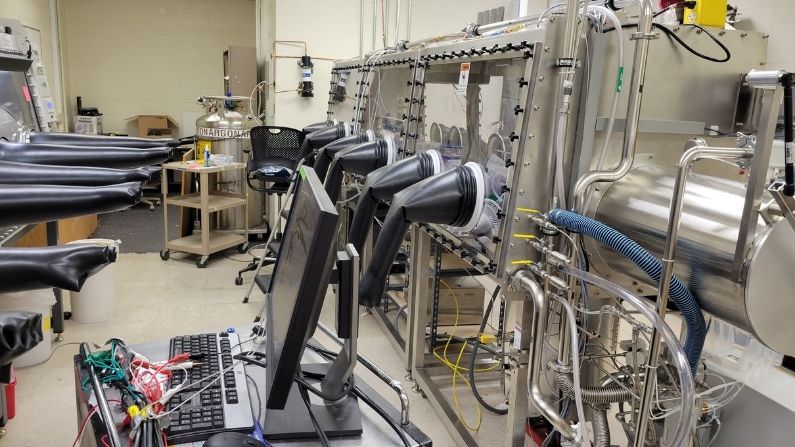This story is part of a collaboration with Rocky Mountain Community Radio focusing on the transition away from fossil fuels across the Mountain West.
It’s the 1950s, the beginning of the Cold War, and American scientists have just developed an incredible new technology. Something that could bring the world endless energy. Dr. Matthew Memmott is an expert in nuclear power and a professor at Brigham Young University.
“So, basically nuclear energy is simply splitting uranium atoms to make heat, which then goes into heating up water, which then goes into creating steam, which then generates electricity via a turbine. And that’s how we’ve conventionally done it for decades,” Memmott said.
He also explained that there are downsides to this technology. Solid fuel rods heat up during the reaction. If they aren’t cooled down—it’s a problem.
“And this is what we refer to as a meltdown scenario,” Memmott said.
Then there’s the waste. You have radioactive leftovers from the process, including some really heavy elements.
“And those last or are radioactive for 300,000 plus years,” Memmott said.
But this way to generate nuclear power—using solid fuel rods—isn’t the only way.
 Molten salt reactors for the production of electrical power were studied at Oak Ridge National Laboratory from 1957 to 1960. The molten salt fuel for this reactor is radically different from that used in solid fuel reactors. Instead of using solid fuel rods, the lab dissolved uranium directly into liquid salt. This was thought to be safer.
Molten salt reactors for the production of electrical power were studied at Oak Ridge National Laboratory from 1957 to 1960. The molten salt fuel for this reactor is radically different from that used in solid fuel reactors. Instead of using solid fuel rods, the lab dissolved uranium directly into liquid salt. This was thought to be safer.
“There’s no such thing as a meltdown accident anymore, because you don’t have solid fuel that can melt,” Memmott said. “Rather it’s dissolved in the salt. It’s already liquid.”
You also get less of that dangerous radioactive waste like plutonium.
“What’s left are the fission products. They’re all floating in this salt. And it turns out the fission products are quite valuable,” Memmott said.
Like gold, platinum and Molybdenum 99, that’s used in medical imaging and worth about $30 million a gram, according to Memmott.
So, what does this have to do with coal-producing Emery County, Utah—population 10,000? The region has lost a lot as Utah transitions away from coal. Thom Carter is Director of the Governor’s Office of Energy Development. His department, along with Emery County commissioners, have a bet to help the region transition.
“Our attitude can’t be ‘Well, thanks Emery County. Thanks, Carbon County. Thanks, Sevier County. You’ve been great. We’re just going to move on from you.’ We have to have the mindset of what can we do to ensure that your way of life can be maintained,” Carter said.
In Orangeville, just down the street from two coal-fired power plants—set to close in the coming decades — is the San Rafael Research Center. It’s a space to test new technology like molten salt nuclear reactors.
“By doing research in these communities, it allows us to better understand what is best for them and not be driven by political winds but to help identify good technology, the access of time and be driven by the markets so that everybody wins in the long run,” Carter said.
The project could in time bring revenue from energy and medical isotopes. And it could bring jobs. It’s received a state grant of 7 million dollars. And the governor’s office has applied for federal funds.
Right now, the research space is being used for just that: research. But the thought is that focusing research here will give the community a leg up in applying the technology. Andrew Fry is an engineer and consultant at San Rafael.
“So that when we get through the first hurdles to the fundamental research, now let’s go to the demonstration scale, now let’s build a big plant,” he said. “If you’re participating in the beginning, it’s easier to be participating at the end. And ultimately, we’d love to see those demonstrations come to Utah.”
It’s unclear if large numbers of new jobs will ever materialize. But so far the center has hired locals.
“We employ former miners and other people already who are doing the grunt work on the research down there,” Fry said. “And they’re excellent at it because they know how to run big equipment.”
Emery County isn’t the only place looking at this long-ignored nuclear technology. Canada is funding research. And scientists in China are testing commercial-scale designs.
But there are still huge obstacles. This type of reactor has never been proven to work on a large scale. And it will take billions in investment.
A report last year by the group Union of Concerned Scientists questions the reactor’s relative safety. That report says there will still be potentially dangerous radioactive waste from the fission process to consider.
But Dr. Memmott, who founded a company to develop this technology, says he’s optimistic, although perhaps a little biased.
“It could easily and quickly shift to being the dominant form of electricity production because of the fact that there’s no emissions,” Memmott said. “There’s no waste. You’re making valuable things. And it’s cheaper than everything else.”
There are some in Emery County who hope that, if molten salt nuclear reactors are the future, then that future includes them.





